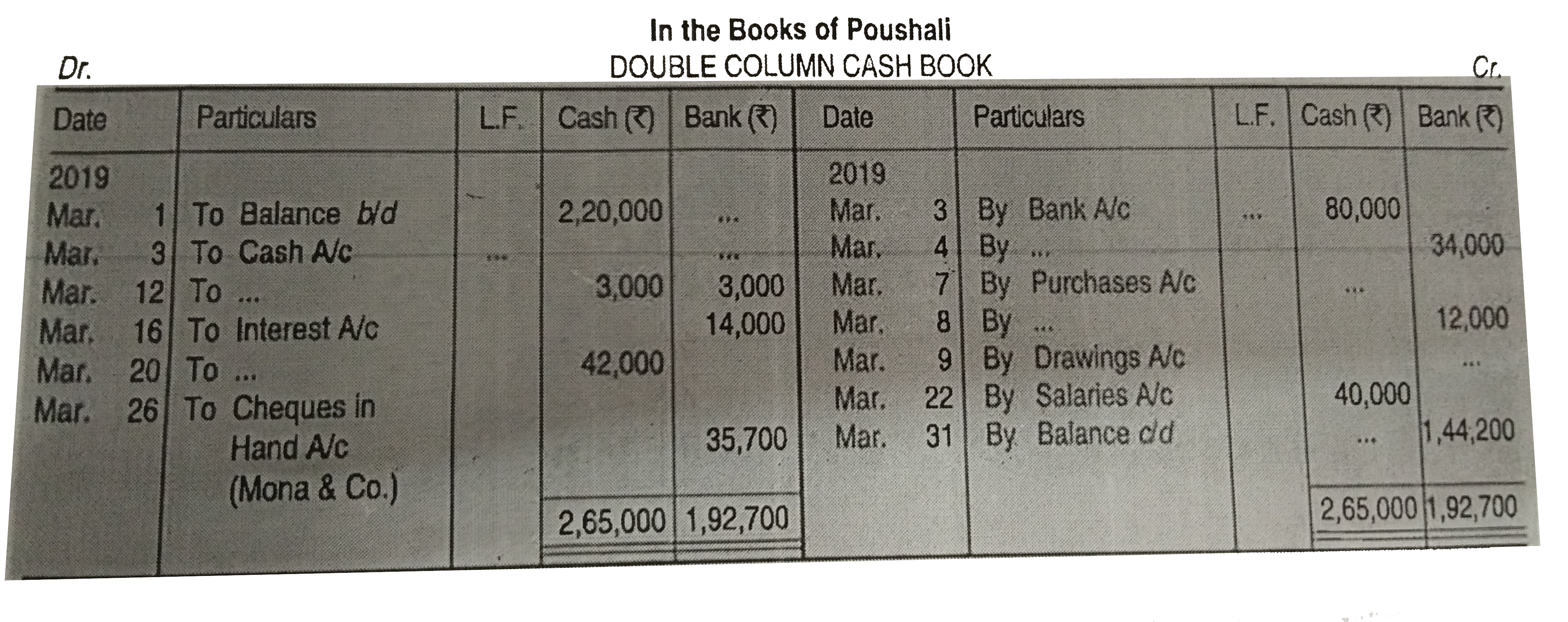Journalise the following entries: Goods worth Rs.500 given as charity. Received Rs.975 from Harikrishna in full settlement of his account for Rs.1 000. Received a first and final dividend of 60 paise in a rupee from the Official Receive Rajan who owed us Rs.1 000. Charged depreciation on plant Rs.1 000.
Journal Entries
Related Solutions
Journalise the following transactions in the books of Ashok: (i) Received Rs. 11,700 from Hari Krishan in full settlement of his account for Rs. 12,000. (ii) Received Rs. 11,700 from Shyam on his account for Rs. 12,000. (iii) Received a first and final dividend of 70 paise in the rupee from the official receiver of Rajagopal who owed us Rs. 7,000. (iv) Paid Rs. 2,880 to A.K. Madal in full settlement of his account for Rs. 3,000. (v) Paid Rs. 2,880 to S.K. Gupta on his account for Rs. 3,000.
View SolutionJournalise the following entries:
(i) Goods costing Rs. 500 given as charity.
(ii) Sold goods to Mayank of Rs. 1,00,000, payable by cheque at the time of sale and balance after 30 days of sale.
(iii) Received Rs. 975 from Harikrishna in full settliment of his account of Rs. 1,000.
(iv) Received a first and final dividend of 60 paise in a rupee from the Official Receiver of Rajan, who owed us Rs. 1,000.
(v) Charge interest on Drawings Rs. 1,500.
(vi) Sold goods costing Rs. 40,000 to Anil for cash at a profit of on cost less trade discount and paid cartage Rs. 100, which is not to be charged from customer.View SolutionFrom the following information calculate Gross Profit Ratio, Inventory Turnover Ratio and Trade Receivable Turnover Ratio.
View SolutionYou are able to collect the following information about a company for two years: {:(,2015-16,2016-17),("Trade receivables on Apr. 01",Rs. 4_(,)00_(,)000,Rs.5_(,)00_(,)000),("Trade receivables on Mar.31",, Rs.5_(,)60_(,)000),("Stock in trade on Mar. 31",Rs.6_(,)00_(,)000,Rs.9_(,)00_(,)000),("Revenue from operations",Rs. 3_(,)00_(,)000,Rs.24_(,)00_(,)000),("(at gross profit of 25%)",,):} Calculate Inventory Turnover Ratio and Trade Receivables Turnover Ratio
View SolutionJournalise the following transactions: (i) Rs. 5,000 due from Ramesh are irrecoverable. (ii) Sohan is declared insolvent. Received from his Official Receiver 60 paise in a rupee on a debt of Rs. 10,000. (iii) Received cash for a bad debt written of last year Rs. 700.
View SolutionCalculate Inventory Turnover Ratio from the data given below:
View SolutionReceived Rs 4,900 from Garima in full settlement of Rs 5,000. Posting of Rs 100 will be made to the :
View SolutionFrom the following, calculate (a) Debt-Equity Ratio (b) Total Assets to Debt Ratio (c) Proprietary Ratio. {:("Equity Share Capital",,Rs.75_(,)000),("Preference Share Capital",,Rs.25_(,)000),("General Reserve",,Rs.45_(,)000),("Balance in the Statement of Profit & Loss",,Rs.30_(,)000),("Debentures",,Rs.75_(,)000),("Trade Payables",,Rs.40_(,)000),("Outstanding Expenses",,Rs.10_(,)000):}
View SolutionCalculate the Trade receivables turnover ratio from the following information:
View SolutionCalculate 'Liquidity Ratio' form the following information: {:("Current liabilities",,=,Rs.50_(,)000,),("Current assets",,=,Rs.80_(,)000,),("Inventories",,=,Rs.20_(,)000,),("Advance tax",,=,Rs.5_(,)000,),("Prepaid expenses",,=,Rs.5_(,)000,):}
View SolutionCalculate debt-equity ratio from the following information:
View SolutionCompute Inventory Turnover Ratio from the following information: {:("Net Revenue from Operations",,Rs.2_(,)00_(,)000),("Gross Profit",,Rs.50_(,)000),("Inventory at the end",,Rs.60_(,)000),("Excess of inventory at the end over",,),("inventory in the beginning",,Rs.20_(,)000):}
View SolutionCompute Gross Profit Ratio, Working Capital Turnover Ratio, Debt Equity Ratio and Proprietary Ratio from the following information
View SolutionFrom the following information calculate: (i) Gross Profit Ratio (ii) Inventory Turnover Ratio (iii) Current Ratio (iv) Liquid Ratio (v) Net Profit Ratio (vi) Working Capital Ratio: {:("Revenue from Operations",,Rs.25_(,)20_(,)000),("Net Profit",,Rs. 3_(,)60_(,)000),("Cost of Revenue from Operations",,Rs. 19_(,)20_(,)000),("Long-term Debts",,Rs. 9_(,)00_(,)000),("Trade Payables",,Rs. 2_(,)00_(,)000),("Average Inventory",,Rs.8_(,)00_(,)000),("Current Assets",,Rs. 7_(,)60_(,)000),("Fixed Assets",,Rs. 14_(,)40_(,)000),("Current Liabilities",,Rs. 6_(,)00_(,)000),("Net Profit before Interest and Tax",,Rs. 8_(,)00_(,)000):}
View SolutionRishi is a partner in a firm. He withdrew the following amounts during the year ended March 31, 2017. {:("May "01", "2017,,"Rs. "12_(,)000,),("July "31", "2017,,"Rs. "6_(,)000,),("September "30", "2017,,"Rs. "9_(,)000,),("November "30", "2017,,"Rs. "12_(,)000,),("January "01", "2018,,"Rs. "8_(,)000,),("March "31", "2018,,"Rs. "7_(,)000,):} Interest on drawings is charged @ 9% p.a. Calculate interest on drawings
View SolutionFrom the following transactions ,state the nature of accounts and state which account will be debited and which account will be credited : {:( ,, "₹") , (1. "Mohan started business with cash" ,, 5"," 00"," 000), ( 2. "Purchased goods for cash" ,, 1"," 00"," 000), (3. "Sold goods for cash" ,, 1","50","000), (4. "Received interest from Ram in cash" ,, 500), (5. "Sold goods to Ashok" ,, 60"," 000), (6. "Purchased furniture for cash" ,, 50 "," 000), (7. "Paid wages" ,, 20","000):}
View SolutionEnter the following transactions in a simple cash book for December 2016:
View SolutionThe dividend received from 10 % Rs. 125 shares at Rs. 150, is Rs. 1875. Find the number of shares.
View Solutionडॉ राजेश कि कुल वार्षिक आय (माकन किराया भत्ता छोड़कर) रूपये 1 ,78 ,000 है। यदि वह सामान्य भविष्य निधि में प्रतिमाह 2 ,500 समूह जीवन बिमा योजना में प्रतिमाह रूपये 180 तथा रूपये 5 ,000 उर्ध्वार्षिक जीवन बिमा प्रीमियम का भुगतान करता है , उस वित्तीय वर्ष में उसे कितना आयकर देना होगा ? आयकर गणना कि सिमा -
(a ) आयकर कि दर :
(i ) रूपये 1 ,10 ,000 तक -शून्य
(ii ) रूपये 1 ,10 ,001 से रूपये 1 ,50 ,000 तक
(iii )रूपये 1 ,10 ,001 से रूपये तक
(iv ) रूपये से ऊपर पर
(b ) शिक्षा उपकार -आयकर कि राशि पर कि दर से देय होगा।View SolutionDetermine the missing values of the Cash Book with Bank Column of Poushli on the basis of following transactions:
 View Solution
View Solution
